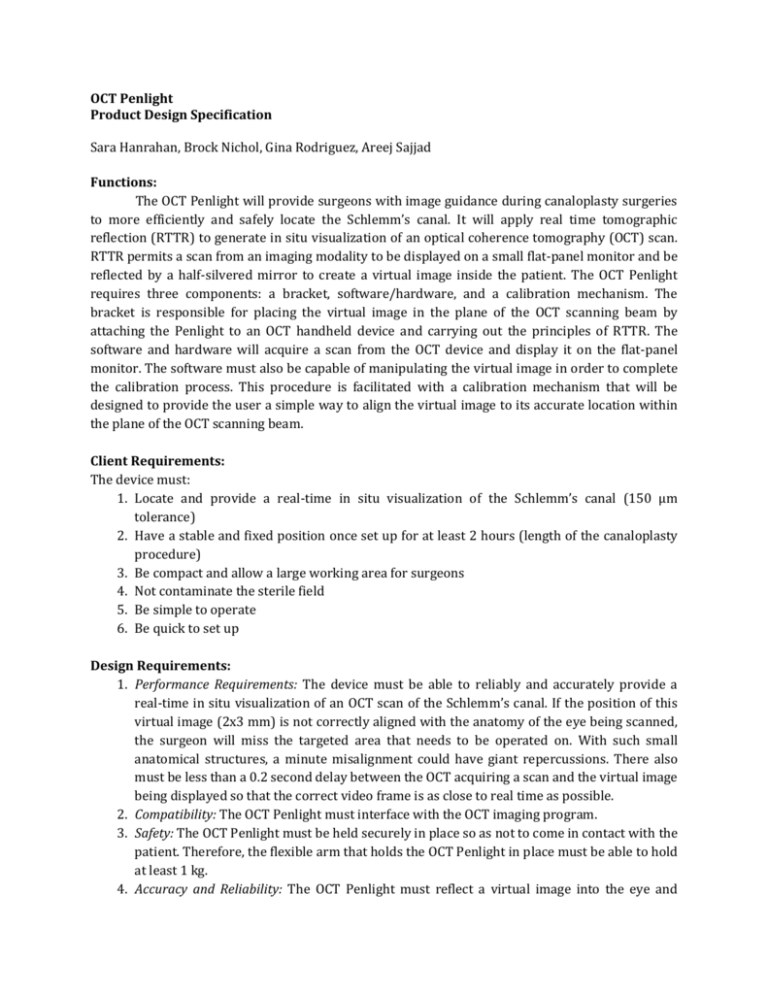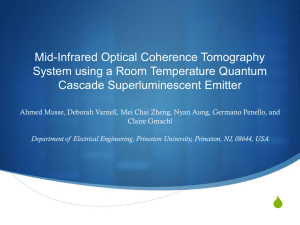Product Design Specifications
advertisement

OCT Penlight Product Design Specification Sara Hanrahan, Brock Nichol, Gina Rodriguez, Areej Sajjad Functions: The OCT Penlight will provide surgeons with image guidance during canaloplasty surgeries to more efficiently and safely locate the Schlemm’s canal. It will apply real time tomographic reflection (RTTR) to generate in situ visualization of an optical coherence tomography (OCT) scan. RTTR permits a scan from an imaging modality to be displayed on a small flat-panel monitor and be reflected by a half-silvered mirror to create a virtual image inside the patient. The OCT Penlight requires three components: a bracket, software/hardware, and a calibration mechanism. The bracket is responsible for placing the virtual image in the plane of the OCT scanning beam by attaching the Penlight to an OCT handheld device and carrying out the principles of RTTR. The software and hardware will acquire a scan from the OCT device and display it on the flat-panel monitor. The software must also be capable of manipulating the virtual image in order to complete the calibration process. This procedure is facilitated with a calibration mechanism that will be designed to provide the user a simple way to align the virtual image to its accurate location within the plane of the OCT scanning beam. Client Requirements: The device must: 1. Locate and provide a real-time in situ visualization of the Schlemm’s canal (150 µm tolerance) 2. Have a stable and fixed position once set up for at least 2 hours (length of the canaloplasty procedure) 3. Be compact and allow a large working area for surgeons 4. Not contaminate the sterile field 5. Be simple to operate 6. Be quick to set up Design Requirements: 1. Performance Requirements: The device must be able to reliably and accurately provide a real-time in situ visualization of an OCT scan of the Schlemm’s canal. If the position of this virtual image (2x3 mm) is not correctly aligned with the anatomy of the eye being scanned, the surgeon will miss the targeted area that needs to be operated on. With such small anatomical structures, a minute misalignment could have giant repercussions. There also must be less than a 0.2 second delay between the OCT acquiring a scan and the virtual image being displayed so that the correct video frame is as close to real time as possible. 2. Compatibility: The OCT Penlight must interface with the OCT imaging program. 3. Safety: The OCT Penlight must be held securely in place so as not to come in contact with the patient. Therefore, the flexible arm that holds the OCT Penlight in place must be able to hold at least 1 kg. 4. Accuracy and Reliability: The OCT Penlight must reflect a virtual image into the eye and locate the Schlemm’s canal with 150 µm accuracy. 5. Life in Service: The device must be able to accurately locate the Schlemm’s canal with a virtual image once a day, 5 days a week, for 2 hours a surgery session over the duration of 6 months until maintenance is needed. 6. Shelf Life: Device should last at least 5 years. Due to multiple uses, the lens, glass, and hardware might need to be replaced. 7. Operating Environment: The device should be able to withstand a surgery room environment. This means temperature ranging from 10˚C to 30˚C. 8. Ergonomics: Once set up, the device can be easily adjusted by maneuvering the flexible arm that has a diameter of about 2 cm. 10 cm will be allowed between the half-silvered mirror and the microscope so the surgeon can operate. The distance between the mirror and the patient should be approximately 6.5 cm. 9. Size: The total device will be about 30 cm by 25 cm. An organic light-emitting diode (OLED) microdisplay that has a resolution of 852 x 600 with 15 micrometer pixels will be used. The virtual image is approximately 2 mm by 3 mm. The half-silvered mirror attached is 4 cm by 2.5 cm by 0.095 cm. All of this is secured tightly to a handheld OCT image acquisition device, which is about 30 cm by 30 cm. 10. Weight: In total (OCT Penlight and OCT handheld), the device will weigh less than 1 kg. 11. Materials: The prototype will be made out of stereolithography material. 12. Cleaning: All components other than any glass on the OCT Penlight are to be wiped with a cloth and disinfectant. Glass can be cleaned carefully with isopropyl alcohol and Kim wipes. Before uses, the device will be sterilized using ethylene oxide gas sterilization. 13. Aesthetics, Appearance and Finish: Components such as the lens of the OCT image acquisition device, the display, and the glass that reflects the display must stay completely clear and untouched. The finish of the other components must be smooth and easy to clean. Product Characteristics 1. Quantity: One OCT Penlight will be constructed. This includes a handheld OCT acquisition device, a flat panel OLED microdisplay, a half-silvered mirror, a VGA to USB video capture device, a bracket, a VGA signal splitter, a flexible arm, and a calibration mechanism. 2. Target Product Cost: At this point the total cost is estimated to be $1,510. This includes an $800 display, $300 bracket, a $10 mirror, a $100 VGA splitter, a $300 VGA to USB video capture device, and a $40 flexible arm. The $85,000 OCT acquisition device has been omitted from the product cost. Miscellaneous 1. Standards and Specifications: The device falls into a class II product and requires both general and specific controls. This includes Premarket Notification (510(k)) along with design controls (21 CFR 820.30) and a guidance document on ophthalmoscopes (regulation number 866.1570). 2. User Training: Before clinical use, one must be trained in operation and set up of device. This includes explaining the electronic connections to the computer, the calibration of the device before each use, the proper positioning needed during surgery, and the running of the program. Only a trained ophthalmologist or technician is permitted to set up the OCT Penlight. 3. Competition: i. OCT imaging: Although OCT allows for real time imaging of the eye’s anatomy, it is not currently used to view the structure of the eye during a surgery. ii. Sonic Flashlight: It uses the same RTTR principles, but it has a much lower resolution making it beneficial for other procedures, but not for locating the Schlemm’s canal. The Sonic Flashlight requires contact with the surface being scanned. iii. Microscopes and the human eye: These alone only allow a view of the surface of the eye.






